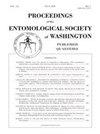Two New Species of Mutualistic Gall Midges (Diptera: Cecidomyiidae) Responsible for the Pollination of Phyllanthus flexuosus (Phyllanthaceae) and Using Its Male Flower Buds as Brood-Sites
IF 0.4
4区 农林科学
Q4 ENTOMOLOGY
Proceedings of the Entomological Society of Washington
Pub Date : 2022-12-08
DOI:10.4289/0013-8797.124.3.499
引用次数: 2
Abstract
Abstract. Two new species of gall midges (Diptera: Cecidomyiidae: Cecidomyiinae) associated with male flower buds of Phyllanthus flexuosus (Phyllanthaceae) are described and illustrated. Clinodiplosis gagnei Elsayed, new species, induces male flower bud galls, whereas Macrolabis katoi Elsayed, new species, is an inquiline. Females of both species visit the host plant at flowering in search of suitable oviposition sites and, in doing so, become dusted with pollen of the opened male flowers and come in contact with the stigmas of female flowers. Larvae of both gall midge species overwinter in the ground, and each has only one generation per year. This is the first report of the genus Macrolabis in Japan.弯叶下珠(Phyllanthus flexusus,Phyllanthaceae)授粉及其雄芽作繁殖地的两个互交性胆蝇新种(直翅目:cidomyidae)
摘要本文描述并举例说明了与弯曲叶下珠(Phyllanthus flexusus,Phyllanthaceae)雄性花蕾相关的两个胆蚊新种(直翅目:蜡蚧科:蜡蚧亚科)。新品种gagnei Elsayed Clinodiplosis可诱导雄性花蕾没食子酸,而新品种katoi Elsayede Macrolabis则是一种新品种。这两个物种的雌性在开花时都会造访寄主植物,寻找合适的产卵地点,在这样做的过程中,它们会沾上开放的雄花的花粉,并与雌花的柱头接触。两种吸浆虫的幼虫都在地下越冬,每年只有一代。这是日本首次报道Macrolabis属植物。
本文章由计算机程序翻译,如有差异,请以英文原文为准。
求助全文
约1分钟内获得全文
求助全文
来源期刊
CiteScore
0.90
自引率
16.70%
发文量
40
审稿时长
>12 weeks
期刊介绍:
The Proceedings of the Entomological Society of Washington is published four times a year in January, April, July, and October. The journal publishes on all aspects of original research in entomology. Subject matter includes systematics, taxonomy, biology, behavior, ecology, morphology, genetics, and other topics.

 求助内容:
求助内容: 应助结果提醒方式:
应助结果提醒方式:


